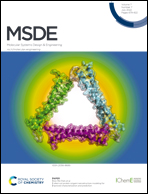Columnar liquid crystals as stability enhancing hole transport layers for Ruddlesden–Popper perovskite optoelectronics
Abstract
Metal halide perovskites are highly promising materials for next generation optoelectronic devices, but they suffer from moisture-driven and thermal degradation. We focus on the prototypical light-absorbing methylammonium lead(II) iodide (MAPbI3) crystal that degrades predominantly into lead iodide (PbI2). In this work, we perform a systematic comparison of the structural and optical properties between perovskites coated with spiro-OMeTAD and a discotic liquid crystal (DLC) 2,3,6,7,10,11-hexakis(pentyloxy)triphenylene (HAT5). Butylammonium iodide (BAI) is used as an additive to make hybrid mixed dimensional (MD) and two-dimensional perovskites. We perform aging studies in a lab environment over a period of 45 days and two sets of conditions are tested; the first set is exposed to humidity that varies between 58 and 36%, and the second set was exposed to the environment and additionally was heated at 65 °C in the atmosphere for four hours every day. Our results demonstrate that the DLC HAT5 molecule results in improved long-term stability of hybrid MD BAI substituted Ruddlesden–Popper perovskites. Some concerns about low phase transition temperatures in working devices are also highlighted. The enhanced stability of perovskite-based optoelectronic devices with the use of HATn HTLs provides a promising molecular engineering approach that can be applied in stable next-generation perovskite optoelectronic devices.



 Please wait while we load your content...
Please wait while we load your content...